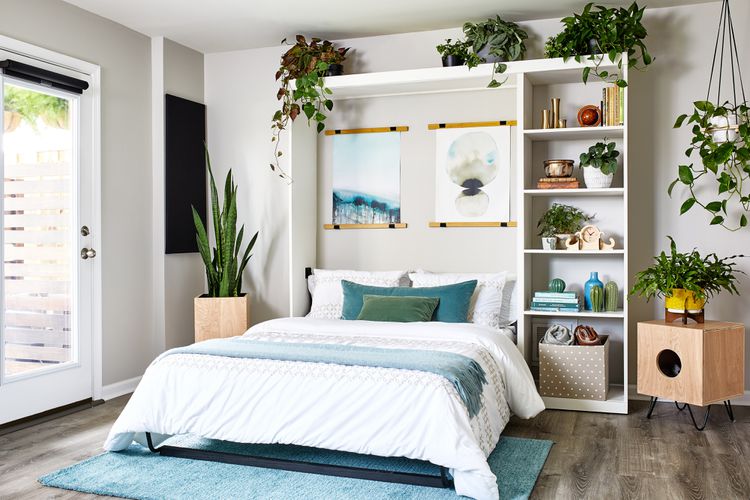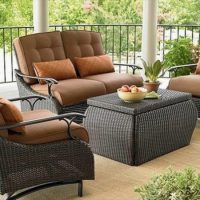Contents
- What exactly is a Murphy bed?
- Essential Considerations Before Purchasing a Murphy Bed
- Factors to Consider When Purchasing Murphy Beds
- Room Arrangement
- Material
- Activation System
- Features
- Types of Murphy Beds
- Murphy Bed
- Cabinet Bed
- Cost
- Tips for Selecting a Murphy Bed
- Horizontal versus Vertical
- Dimensions of the Mattress
- Will you need assistance in adjusting the height of the bed?
- How frequently do you plan to utilize the Murphy bed?
- Alternative Storage or Practical Applications
- Shopping Destinations
- Purchasing at a Physical Location
- Purchasing via the Internet
- Where to Purchase a Murphy Bed

Create additional space in your bedroom or guest room with a Murphy bed. Often referred to as a wall bed, this innovative bed design can be folded away when not in use, hiding the mattress and showcasing a sturdy exterior, which can be designed to resemble a cabinet. The key benefit of a Murphy bed is the opportunity to reclaim floor space when the bed is not in use.
Deciding to buy and set up a Murphy bed can be overwhelming, especially if you’re not well-versed in the various features and designs on the market. It’s essential to choose a bed that aligns with your room’s purpose, is simple to operate, and is built to withstand the test of time. This guide will provide insights into the different types of Murphy beds, key factors to consider when purchasing, and tips on where to locate and buy a wall bed.
What exactly is a Murphy bed?
A Murphy bed, often referred to as a wall bed, is designed to be attached to the wall and includes a folding mechanism that allows the mattress to be easily lifted and lowered. When the bed is not in use, it can resemble a cabinet or integrated shelving unit.
Essential Considerations Before Purchasing a Murphy Bed
If you’ve been evaluating your room, you may have noticed the necessity to optimize your floor area. A Murphy bed serves as an excellent solution, as these beds can be folded away when not in use, freeing up valuable space. They are commonly found in guest rooms or offices that also function as sleeping areas for visitors. However, you might also think about incorporating a Murphy bed in your main bedroom to fully utilize the space you have. Additionally, compact homes or studio apartments can greatly benefit from a Murphy bed. You can set up your bed for the night and then fold it away during the day, allowing for a more spacious living environment.
Factors to Consider When Purchasing Murphy Beds
Room Arrangement
When selecting a Murphy bed, it’s crucial to take into account the arrangement of your room. Begin by measuring the area to understand the available dimensions. Since the majority of Murphy beds fold up vertically, it’s essential to determine the height from the floor to the ceiling. If your ceiling is on the lower side, consider opting for a Murphy bed that folds horizontally.
When considering a Murphy bed for a compact area, it’s important to take note of its fully extended length when deployed. Ensure that there is sufficient room to fully open the bed and to comfortably access it, including the space needed to lift it back into its upright position.
Material
Murphy beds can be constructed from a range of materials such as solid wood, engineered wood, particleboard, and metal. Solid wood offers exceptional durability, though it tends to be quite heavy. Engineered wood and particleboard are lighter alternatives, but they might come with a lower weight capacity and potential long-term durability concerns. Metal Murphy beds are robust and are often combined with wooden cabinets or shelving units.
Activation System
When looking for a Murphy bed, the lifting mechanism is a crucial factor to take into account. Generally, these beds are equipped with either a piston (hinge) lift or a spring lift. Additionally, there are Murphy beds that utilize a manual opening system, requiring you to lift and lower the bed with your own effort.
Spring-operated mechanisms were the initial widely used system for lifting Murphy beds. The tension of the spring can typically be modified to facilitate the lifting of the bed. Contemporary spring-assisted mechanisms often include safety features to prevent abrupt retraction.
A piston-assisted lifting mechanism employs pressurized arms, providing a convenient method for raising and lowering a Murphy bed. Numerous beds featuring pistons include a locking system that ensures the bed remains safely stowed when not in operation.
Manual opening systems are the most straightforward, as they lack springs or pistons that require adjustment. This simplicity, however, means that you will need to bear the entire weight of the mattress and frame when raising or lowering the bed. Consequently, certain manufacturers of Murphy beds with manual opening systems advise that two people should always be present to assist with the setup or storage of the bed.
Features
Incorporating various features can enhance your experience with a Murphy bed. A key attraction when selecting a Murphy bed is the availability of storage solutions, particularly beneficial for studio apartments. Built-in shelves or cabinets on the sides, bottom, or top of the bed frame can provide ample space for blankets, bedding, clothing, or other necessities. Additionally, some Murphy beds come with a versatile design that includes a desk for use when the bed is not in use. Another popular feature is integrated LED lighting, which is particularly useful for reading in bed.
Types of Murphy Beds
Murphy Bed
Although the terms Murphy bed and wall bed are often used synonymously to describe a bed that is mounted to the wall, the term “wall bed” can also refer to a particular design of Murphy bed. Typically, wall beds are built into a structure that covers a significant portion, if not the entirety, of the wall. When not in use, a wall bed can resemble cabinets, a shelving system, or a bookcase.
This type of Murphy bed could be perfect for those seeking a subtle appearance. The design seamlessly integrates into the surroundings, hiding the bed within. Wall beds that occupy a significant portion, or the entirety, of a wall tend to be pricier and may require custom construction to achieve a fully cohesive aesthetic.
Cabinet Bed
A different variation of the Murphy bed is the cabinet bed. These beds can either be attached to the wall or stand alone as freestanding units that allow the bed to fold inside. Compared to traditional wall-mounted Murphy beds, cabinet beds offer greater flexibility, making them ideal for renters or individuals with limited wall space. However, they might not provide the same size, stability, or storage options that wall-mounted beds can offer.
Cost
The price of a Murphy bed largely depends on its dimensions and the materials used. For a queen-sized model crafted from solid wood, the price typically ranges from $2,000 to $4,000. In contrast, a Murphy bed made from manufactured wood or particle board tends to be more affordable, generally costing between $1,000 and $1,800.
Additional elements that affect the pricing of a product encompass the type of opening mechanism employed. Systems that utilize piston assistance for lifting tend to elevate the cost of a Murphy bed, whereas manual opening mechanisms represent the simplest and most economical choice. Moreover, features like built-in storage or lighting can further contribute to the overall expense of a Murphy bed.
Tips for Selecting a Murphy Bed
Murphy beds have seen a revival in popularity since they first became widely available nearly a hundred years ago. This renewed interest is driven by several factors, particularly the trend towards maximizing space and efficiency, which is a hallmark of the tiny house movement. Consequently, there is a wide range of options available to suit various needs and budgets. When selecting a Murphy bed, it is essential to consider aspects that will enhance its functionality, ease of use, and aesthetic appeal in your environment. Here are some key factors to keep in mind when making your choice.
Horizontal versus Vertical
Begin by deciding if you prefer a horizontal or vertical wall bed, which pertains to the mattress’s alignment. Vertical wall beds are the most prevalent, featuring a mechanism that raises and lowers the foot of the bed. While they occupy less wall space, they require more room when fully extended. On the other hand, horizontal wall beds are a suitable option, particularly in spaces with limited depth. These beds fold along their longer side instead of adjusting the foot of the bed.
Dimensions of the Mattress
Murphy beds are available in sizes that correspond to standard mattress dimensions. You can choose from twin, full, queen, and king wall beds, with twin and queen sizes being the most prevalent. When selecting a Murphy bed, it’s important to ensure that the depth of your mattress aligns with the bed’s design. Typically, these beds can support mattresses that are between 8 and 12 inches thick.
Will you need assistance in adjusting the height of the bed?
Remember that Murphy beds can be quite heavy, particularly when you include the mattress weight. Consider whether you will be handling the lifting and lowering of the bed by yourself or with assistance. If you plan to set up and store the bed independently, it would be wise to seek a lifting mechanism that is either designed for solo use or offers assistance.
How frequently do you plan to utilize the Murphy bed?
Think about whether you plan to use a Murphy bed nightly or just for occasional guests. If you need a bed for a multifunctional office that serves purposes beyond just accommodating visitors, a freestanding, cabinet-style Murphy bed could be a suitable option. However, if you intend to use the Murphy bed every night in your bedroom or living area, you may have extra requirements regarding comfort, convenience, or storage solutions.
Alternative Storage or Practical Applications
Do you have specific expectations for your Murphy bed beyond providing a cozy spot for rest? If you find yourself lacking in closet or storage options, opting for a wall bed that includes built-in storage can be highly beneficial. You can keep your bed linens or other belongings in the cabinets or drawers. Open shelving can serve as a display for decorative items or books. Moreover, certain wall beds serve multiple purposes, functioning as a desk or workspace as well.
Shopping Destinations
Purchasing at a Physical Location
When purchasing a Murphy bed in a physical store, you have the opportunity to examine its appearance and functionality prior to making a purchase. You can observe the bed in both its open and closed states and inspect the lifting mechanism personally. Typically, the bed will be sold in boxes, and you will need to assemble it at home. Certain retailers might provide a white glove delivery service to simplify the experience.
Purchasing via the Internet
You can find an extensive selection of Murphy beds online, providing you with a wide range of styles and finishes. As you explore the website, be sure to focus on the dimensions, the type of lifting mechanism, and the specifics of any warranties or return policies. Additionally, think about the level of assembly needed and whether the company provides premium delivery services.
Where to Purchase a Murphy Bed
A wide range of retailers offer Murphy beds for sale. If you’re looking to purchase a wall bed in a physical store, a regional or national furniture outlet is probably your best option. However, there are numerous online retailers that specialize in wall beds. Wayfair and Amazon are among the most well-known online platforms for buying Murphy beds, and you can also explore the online stores of major retailers such as Costco, Walmart, and Home Depot. Additionally, there are retailers that focus primarily on wall beds, such as Lori Wall Beds, BredaBeds, and Resource Furniture, where you can shop online.
Is it necessary to secure a Murphy bed to the wall?
The majority of Murphy beds typically require wall anchoring and may need to be secured to a stud for enhanced stability. Nevertheless, certain models can be affixed to the floor.
Do I have to take off the baseboards to set up a Murphy bed?
It’s not always required to take off baseboards when installing a Murphy bed, but it’s essential for the bed to fit snugly against the wall. Since most rooms come with baseboards, most Murphy bed designs include a baseboard notch. Additionally, you may have the option to tailor the notch size if your baseboards have specific measurements.
What type of mattress is ideal for a Murphy bed?
A robust, high-density foam mattress is ideal for a Murphy bed. Memory foam and latex options are often suggested. The firm foam construction of these mattresses is resistant to becoming deformed or uneven, even when kept upright for long durations.


 Can I Leave My Outdoor Furniture Outside In The Rain? Essential Tips for Protecting Your Furniture
Can I Leave My Outdoor Furniture Outside In The Rain? Essential Tips for Protecting Your Furniture Tips for Cultivating and Maintaining Peperomia Orba (Peperomia Pixie Lime)
Tips for Cultivating and Maintaining Peperomia Orba (Peperomia Pixie Lime) Top 5 Tips for Balcony Repair to Make Your Outdoor Space Look Like New
Top 5 Tips for Balcony Repair to Make Your Outdoor Space Look Like New